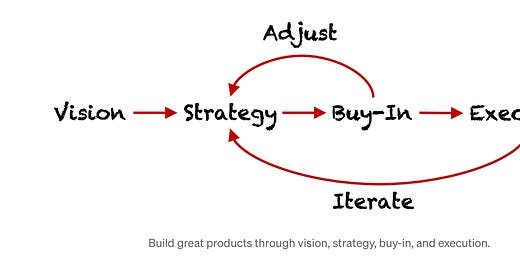As we transition from our deep dive into product vision, it’s essential to pause and address a critical question: What bridges the gap between vision and execution? The answer lies in understanding the relationship between product vision and product strategy.
What Is Product Strategy?
While vision is aspirational, product strategy is practical. It’s the plan of action that turns your dream into reality. Strategy outlines the what, how, and when:
What goals to achieve.
How resources will be allocated.
When milestones will be delivered.
If product vision is the “why,” product strategy is the vehicle that takes you there.
Real-World Example: Duolingo
Duolingo’s vision is: “To make language learning accessible to everyone.”
Their strategy includes:
Offering a freemium model to maximize reach.
Gamifying learning to enhance engagement.
Expanding into language certifications (like Duolingo English Test) to monetize further.
This strategy not only delivers results but also ensures they remain true to their vision.
Key Differences Between Product Vision and Product Strategy
How Vision and Strategy Work Together
Picture this: You’re tasked with organizing a marathon.
The vision is to promote community health and wellness.
The strategy involves planning the route, securing sponsorships, and creating marketing campaigns.
A mismatch between the two can spell disaster:
Without vision: The marathon might lack purpose or community buy-in.
Without strategy: The marathon may never leave the starting line.
The Vision-Strategy Connection
Here's how vision and strategy work together in practice:
Vision sets direction
Strategy defines path
Execution brings it to life
Pitfalls of Misalignment
Vision Without Strategy: Leads to lofty ambitions without execution. Teams become frustrated, and progress stagnates.
Strategy Without Vision: Results in disjointed efforts that might achieve short-term wins but lack cohesive direction.
Example: Yahoo’s aggressive acquisition strategy in the 2000s lacked a unifying vision, leading to scattered efforts and missed opportunities.
Balancing the Two: Lessons from Pixar
Pixar, known for its groundbreaking films, offers an excellent example of balancing vision and strategy.
Vision: To make timeless, emotionally resonant stories.
Strategy: Develop innovative animation technology, empower creative teams, and maintain a ruthless focus on storytelling.
This duality allows Pixar to push technological boundaries while delivering heartwarming tales like Toy Story, Finding Nemo, and Soul.
Practical Steps for PMs: Transitioning from Vision to Strategy
Break Down the Vision: Identify the core pillars of your vision.
Example: If your vision is “Empowering remote teams,” pillars could include seamless communication, collaboration, and security.
Prioritize with Impact in Mind: Use frameworks like RICE (Reach, Impact, Confidence, Effort) to decide where to start.
Test and Iterate: Regularly validate your strategy against the vision. Ask, “Are we still aligned?”
As you craft your product’s future, remember: vision inspires, and strategy delivers. The two are inseparable, forming a dynamic duo that fuels innovation and growth. As a product manager, mastering both—and knowing when to focus on each—is essential for driving meaningful results.
Stay tuned as we dive deeper into product strategy in the coming weeks. In the meantime, reflect:
Is your vision clear and compelling?
Does your strategy provide a realistic path to achieving it?
Let’s learn from the successes—and missteps—of those before us to build products that matter.
This Week's Featured Job Openings
Company: CrowdStrike
Location: Remote, USA
Company: Cox Industries
Location: Multiple locations, USA
Company: Rapid7
Location: Arlington, VA
Company: ID.me
Location: Mountain View, CA
Director of Product Management
Company: Cloudflare
Location: Remote, USA





